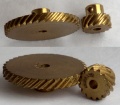TSM 08 Periaktos: Difference between revisions
No edit summary |
No edit summary |
||
| Line 16: | Line 16: | ||
== Solution and Construction == | == Solution and Construction == | ||
<gallery> | |||
Image:Helical_gears.jpg | |||
</gallery | |||
For rigidity, the periaktos would "float" within a steel structure, with two control chains/tracks; one above and one below the periaktos. | For rigidity, the periaktos would "float" within a steel structure, with two control chains/tracks; one above and one below the periaktos. | ||
| Line 25: | Line 29: | ||
Two roller chains or toothed belts (one above the periaktos, one below) would go around the two groups of sprockets/pinions, and off to the control bar. | Two roller chains or toothed belts (one above the periaktos, one below) would go around the two groups of sprockets/pinions, and off to the control bar. | ||
On the centre of the control bar would be a helical gear, with a partner helical gear at right angles to the first. Through this second gear would run a horizontal control bar, with some kind of handle for turning. | On the centre of the control bar would be a helical gear, with a partner helical gear at right angles to the first. Through this second gear would run a horizontal control bar, with some kind of handle for turning. | ||
Revision as of 14:00, 10 March 2008
The aim of this project is to research periaktos, as once used in early forms of Greek, and later, Renaissance Theatre, with a view to designing and constructing a group of periaktoi. I will be looking at various different details, including the design, construction, costings and workability of creating a small number of simultaneously-rotating triangular prisms for use in the New Athenaeum Theatre, RSAMD. The periaktos would be mechanically controlled.
Background
Periaktos were originally used in Greek theatre as a way of providing different painted scenes that allowed easy movement from one to the next. Different shapes have been used, but the triangular prism has become most common. They could be used in different positions around the stage, and in different configurations.
In this project, the periaktos will be positioned USC, with three consecutively changing prisms.
Requirements
The periaktos must be controlled mechanically from onstage. Although the mechanism will be seen, it should not impede with the movement of the periaktos, or with the audience's ability to see them.
Each pariaktoi should be made of three 7500x25000 (mm) panels, fitting in an overall steel structure with a footprint of no more 30000x7500x25000 (mm).
